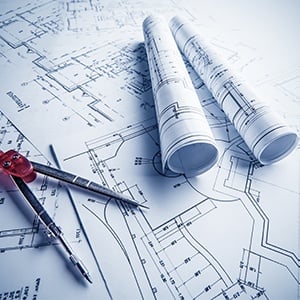
For starters, this is one of those questions that has an “it all depends…” answer, because every office renovation project (just as every organization) is different, and there is no one-size-fits all answer.
Yet with this being said, there are distinct differences between architecture vs. design. We will highlight these below to give you a broader sense of what type of expertise and support will be required to achieve your office renovation goals and objectives.
Basic Role of Architects
An architect is a specialist who draws up office renovation plans that incorporate various essential aspects such as functionality, engineering requirements, esthetics, safety, and so on. They are necessary for any office renovation project that will involve changes to a building’s exterior, or internal changes that would impact structural integrity (e.g. removing walls, etc.).
While in the past architects did this meticulous work by hand (we can all recall the old image of an architect toiling away on a drafting table with pencils and rulers!), on today’s business landscape architects use advanced software to build and modify 3D models. This is much more efficient, and is especially valuable when it comes to evaluating different approaches and possibilities.
Once a plan is approved and finalized, architects supervise and liaison with the construction firm that will carry out the office renovation vision and bring it to life. This quality of this relationship is of critical importance, since issues often emerge – some positive, and some negative – and adjustments and decisions must be made quickly and competently. Architects also communicate and provide updates to project managers, who ultimately keep customers informed on progress, issues, schedules, budgets, etc.
Basic Role of Interior Designers
Interior designers focus on the inside elements of a work environment. This includes helping organizations evaluate and ultimately make strategic decisions regarding materials, flooring, wall coverings, furniture, equipment, FFE, ergonomics, lighting, colors, and so on.
At the same time – and just as importantly – interior designers help organizations maximize and optimize their space, in order to enhance employee engagement, workflow efficiency, quality, performance and branding.
Overlapping Skillsets
While as noted above there are key differences between architecture vs. design, there are some overlapping skillsets as well. For example, both architects and interior designers are familiar with building codes and zoning regulations, as well as ways to reduce energy consumption – which not only lowers monthly utility bills, but reduces carbon footprint as well.
Learn More
To learn more about architecture vs. design, and discover the specialists that should be part of your office renovation project, contact Key Interiors today. Your consultation with us is free.
